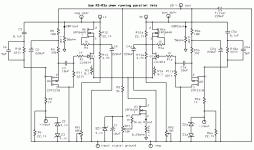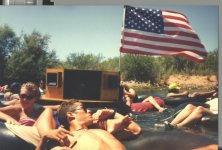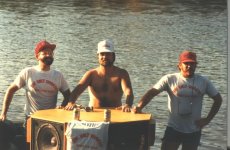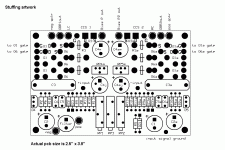This sounds like a perfect project to use with my Edgarhorn Slimlines. 5 watts is cool...10 might be better, but 5 is still 2x than what I have now.
Well, they're at least 10 watts when you up the bias current--I'm still at 20 volts, but these seem perfect for my paper mache HF horns. These pups have plenty of power to drive my 2446 JBL's.
Soon I will attempt to catch up with Magura😉 and run 45 volts. These will go towards my JBL 2123 10" midbass cabinets.
The sound quality is much smoother with the CCS passing four amps vs. two. There's two jfets to feed, and they both want two amps. Make certain that the source resistor is 0.25 ohms.
What I notice most is the lush vocals--the mids are very full sounding. And talk about smooth! Wow.😀
John
Soon I will attempt to catch up with Magura😉 and run 45 volts. These will go towards my JBL 2123 10" midbass cabinets.
The sound quality is much smoother with the CCS passing four amps vs. two. There's two jfets to feed, and they both want two amps. Make certain that the source resistor is 0.25 ohms.
What I notice most is the lush vocals--the mids are very full sounding. And talk about smooth! Wow.😀
John
Attachments
Capenter, I've been meaning to ask you, do you run some kind of +6db/octive boost to your horn set-up? certain types of horns are supposed to need that but I've never actually found it to be true😕
Just for LOL,,, the pic below is tha last time I used a horn. Some Arizona summertime fun on the river 😀
Those are EV's
Just for LOL,,, the pic below is tha last time I used a horn. Some Arizona summertime fun on the river 😀
Those are EV's
Attachments
Hi Lee,
Haha, that river scene is beyond cool. What fun.
I do not use any boost on my HF horns. There is a CD (constant directivity) horn boost button on my TDM X-over, but I don't like the way the top end boost slices my ears off!😀 😉
John
Haha, that river scene is beyond cool. What fun.
I do not use any boost on my HF horns. There is a CD (constant directivity) horn boost button on my TDM X-over, but I don't like the way the top end boost slices my ears off!😀 😉
John
I've made the necessary modifications to my pcb artwork and have submitted it to Express PCB for three more of their little 2.5" x 3.8" boards. I adjusted the pcb for future applications by placing traces for mosfet cascode operation in addition to the jfet.
If they operate without flaws, I'd be willing to order more for those who want them.
One pcb from my last purchase of three was immediately converted to the cascode version of the ZV7-TB, so it never saw it's original application. Now, I have two pcbs for the ZV7-TB that will probably never get used. How can one go back to standard operational procedure once they've tasted what a cascode can do?
Man...
John🙂
If they operate without flaws, I'd be willing to order more for those who want them.
One pcb from my last purchase of three was immediately converted to the cascode version of the ZV7-TB, so it never saw it's original application. Now, I have two pcbs for the ZV7-TB that will probably never get used. How can one go back to standard operational procedure once they've tasted what a cascode can do?
Man...
John🙂
Carpenter, "(constant directivity)" that's it. I know what you mean... Like I said, I never found it to be the ticket either. Somewhat less was designed into that system. It's a tough job propagating with no walls, in open air, 360 degrees. But, like you said, what fun. 😀 😀 😀
That system was bi-amped with 4 Pyle Pro 15's driven by a 120 watt Carver and 4 EV constant directivity horns driven by a JVC 100 Watt. Used CD's or Casettes and my own bi-amp'ed pre with bass boost and horn EQ from OP27's (I was the Device Eng for Op-Amps at Motorola at the time (Mid 80's)). All the power for the 4 hour trip came from a Sears deep cycle DieHard. Weighed over 300lbs (135Kg). Floats on a 60" tracter tube.
Actually I think that's me under the flag. Must have been a 4th of July float...
Just for a few more giggles, that's me with the Beck's hat 😀
That system was bi-amped with 4 Pyle Pro 15's driven by a 120 watt Carver and 4 EV constant directivity horns driven by a JVC 100 Watt. Used CD's or Casettes and my own bi-amp'ed pre with bass boost and horn EQ from OP27's (I was the Device Eng for Op-Amps at Motorola at the time (Mid 80's)). All the power for the 4 hour trip came from a Sears deep cycle DieHard. Weighed over 300lbs (135Kg). Floats on a 60" tracter tube.
Actually I think that's me under the flag. Must have been a 4th of July float...
Just for a few more giggles, that's me with the Beck's hat 😀
Attachments
The fellow on the right? Handsome lad!🙂 Wish we could have been friends back then. That's a sharp looking speaker you're standing next to. That's a lot of playing for one battery--good engineering.
Hey winslow, when I get my pcbs (next Thursday), I'll stuff one up and light it. If all goes well, I'll let you know. I'll be ordering more and throw a couple on the order for you. Mind you, these pcbs are NOT solder-masked or silk-screened. Still, it's not too tough to follow the artwork and stuff them correctly.
John
Hey winslow, when I get my pcbs (next Thursday), I'll stuff one up and light it. If all goes well, I'll let you know. I'll be ordering more and throw a couple on the order for you. Mind you, these pcbs are NOT solder-masked or silk-screened. Still, it's not too tough to follow the artwork and stuff them correctly.
John
Attachments
Oh, and by the way, I don't use the feedback loop for the high frequency amplifier. It's only there for the midbass, where I may require dampening factor. It's also easier to design a feature into a circuit board and not put it to use, than to require it and be without.
I'm in the process of fabricating the chassis for my new ZV7 and only get about 15 min. listening on the original small-horn-amp heatsinks. But, every time I listen. Wow. I really can't remember ever hearing anything this beautiful sounding. The more I listen, the more I realize that the original ZV7-T I've been working on for the last year is history, it's in the archives, baby! Long live the new ZV7-TJBC.
I'm not exaggerating, folks.
John🙂
I'm in the process of fabricating the chassis for my new ZV7 and only get about 15 min. listening on the original small-horn-amp heatsinks. But, every time I listen. Wow. I really can't remember ever hearing anything this beautiful sounding. The more I listen, the more I realize that the original ZV7-T I've been working on for the last year is history, it's in the archives, baby! Long live the new ZV7-TJBC.
I'm not exaggerating, folks.
John🙂
http://www.onsemi.com/pub/Collateral/NTY100N10-D.PDF
These are similar. I played a bit with these a while ago. Had to face the fact that the package does not make heatsinking easy. The ratings of these devices is HIGHLY optimistic. Compared to a TO-247 device like the IRFP240 you just get a whopping input capacitance and not a whole lot more.
Magura 🙂
These are similar. I played a bit with these a while ago. Had to face the fact that the package does not make heatsinking easy. The ratings of these devices is HIGHLY optimistic. Compared to a TO-247 device like the IRFP240 you just get a whopping input capacitance and not a whole lot more.
Magura 🙂
I had hoped to use them in a bass ZV7-TBC amplifier. They're rated for 500 volts! Wow....... Even if I derate them, it looks like they'll handle plenty of wattage. As far a mounting goes, they look like the big, big weight-lifting brother of the IRFP240.
I can't see any problems screwing them down to a heatsink. Is there something I'm missing?
John🙂
I can't see any problems screwing them down to a heatsink. Is there something I'm missing?
John🙂
Yes there is something you're missing here. The input capacitance! It's several times the input capacitance of an IRFP240, but you won't get much more power. If you want more power you'd be better off running 2*IRFP240 in parallel.
Magura 🙂
Magura 🙂
Well now.... since they were free, it won't hurt to play.
So, help me out here Magura. If these are used below 600 hz., couldn't I bias them up with lots of voltage in the cascode configuration? They do pretty much what the jfet asks, right?
This is just for fun, now...
🙂
So, help me out here Magura. If these are used below 600 hz., couldn't I bias them up with lots of voltage in the cascode configuration? They do pretty much what the jfet asks, right?
This is just for fun, now...
🙂
I could run them at 100 volts coupled with the 2 amps supplied by the jfet. 200 watts falls about halfway in their max wattage rating.
As long as they were free, what the **** 🙂
They will sure work just fine in a cascode, just don't expect to get much more power handling than you get from an IRFP240.
Magura 🙂
They will sure work just fine in a cascode, just don't expect to get much more power handling than you get from an IRFP240.
Magura 🙂
The IRFP240 only handles 150 watts max, while the IXTK33N50 handles 415. Do you think they cheated that much on their specs?
To make a TO-264 handle 415W you need to run it submerged in liquid nitrogene or the like 😉
Your main limitation is how to get the heat from the device to the heatsink. IRFP240 will handle like 70W reasonably reliably running at like 60C. Now if you do the math and multiply the max load handling with the same factor as the footprint is bigger....you will end up not too far from the IRFP240
Magura 🙂
Your main limitation is how to get the heat from the device to the heatsink. IRFP240 will handle like 70W reasonably reliably running at like 60C. Now if you do the math and multiply the max load handling with the same factor as the footprint is bigger....you will end up not too far from the IRFP240
Magura 🙂
- Status
- Not open for further replies.
- Home
- Amplifiers
- Pass Labs
- ZV7-T (transformer)



